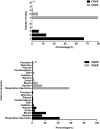Clinical characteristics of carbapenem-resistant Klebsiella pneumoniae infection/colonisation in the intensive care unit: a 9-year retrospective study
- PMID: 37308270
- PMCID: PMC10277079
- DOI: 10.1136/bmjopen-2022-065786
Clinical characteristics of carbapenem-resistant Klebsiella pneumoniae infection/colonisation in the intensive care unit: a 9-year retrospective study
Abstract
Objectives: Carbapenem-resistant Klebsiella pneumoniae (CRKP) infection/colonisation has been reported in hospitals. The clinical characteristics of CRKP infection/colonisation in the intensive care unit (ICU) have received little attention. This study aims to investigate the epidemiology and extent of K. pneumoniae (KP) resistance to carbapenems, the sources of CRKP patients and CRKP isolates, and the risk factors for CRKP infection/colonisation.
Design: Retrospective single-centre study.
Data source: Clinical data were obtained from electronic medical records.
Participants: Patients isolated with KP in the ICU from January 2012 to December 2020.
Main outcome measures: The prevalence and changing trend of CRKP were determined. The extent of KP isolates resistance to carbapenems, the specimen types of KP isolates, and the sources of CRKP patients and CRKP isolates were all examined. The risk factors for CRKP infection/colonisation were also assessed.
Results: The rate of CRKP in KP isolates raised from 11.11% in 2012 to 48.92% in 2020. CRKP isolates were detected in one site in 266 patients (70.56%). The percentage of CRKP isolates not susceptible to imipenem increased from 42.86% in 2012 to 98.53% in 2020. The percentage of CRKP patients from general wards in our hospital and other hospitals gradually converged in 2020 (47.06% vs 52.94%). CRKP isolates were mainly acquired in our ICU (59.68%). Younger age (p=0.018), previous admission (p=0.018), previous ICU stay (p=0.008), prior use of surgical drainage (p=0.012) and gastric tube (p=0.001), and use of carbapenems (p=0.000), tigecycline (p=0.005), β-lactams/β-lactamase inhibitors (p=0.000), fluoroquinolones (p=0.033), and antifungal drugs (p=0.011) within the prior 3 months were independent risk factors for CRKP infection/colonisation.
Conclusions: Overall, the rate of KP isolates resistance to carbapenems increased, and the severity of this resistance significantly increased. Intensive and local infection/colonisation control measures are necessary for ICU patients, especially those with risk factors for CRKP infection/colonisation.
Keywords: adult intensive & critical care; epidemiology; infection control; microbiology.
© Author(s) (or their employer(s)) 2023. Re-use permitted under CC BY-NC. No commercial re-use. See rights and permissions. Published by BMJ.
Conflict of interest statement
Competing interests: None declared.
Figures




Similar articles
-
The Colonization of Carbapenem-Resistant Klebsiella pneumoniae: Epidemiology, Resistance Mechanisms, and Risk Factors in Patients Admitted to Intensive Care Units in China.J Infect Dis. 2020 Mar 16;221(Suppl 2):S206-S214. doi: 10.1093/infdis/jiz622. J Infect Dis. 2020. PMID: 32176790
-
Molecular Epidemiology and Risk Factors of Carbapenem-Resistant Klebsiella Pneumoniae Bloodstream Infections in Wuhan, China.Curr Med Sci. 2022 Feb;42(1):68-76. doi: 10.1007/s11596-021-2480-5. Epub 2022 Jan 4. Curr Med Sci. 2022. PMID: 34985611
-
Risk Factors for Carbapenem-resistant Klebsiella pneumoniae Infection and Mortality of Klebsiella pneumoniae Infection.Chin Med J (Engl). 2018 Jan 5;131(1):56-62. doi: 10.4103/0366-6999.221267. Chin Med J (Engl). 2018. PMID: 29271381 Free PMC article.
-
Risk factors for carbapenem-resistant Klebsiella pneumoniae infection relative to two types of control patients: a systematic review and meta-analysis.Antimicrob Resist Infect Control. 2020 Jan 31;9(1):23. doi: 10.1186/s13756-020-0686-0. Antimicrob Resist Infect Control. 2020. PMID: 32005246 Free PMC article.
-
Relationship between antibiotic exposure and carbapenem-resistant Klebsiella pneumoniae infection within four types of control patients: A systematic review and meta-analysis.J Glob Antimicrob Resist. 2023 Jun;33:137-151. doi: 10.1016/j.jgar.2023.02.020. Epub 2023 Mar 10. J Glob Antimicrob Resist. 2023. PMID: 36906174
Cited by
-
Carbapenem-Resistant Klebsiella pneumoniae in COVID-19 Era-Challenges and Solutions.Antibiotics (Basel). 2023 Aug 4;12(8):1285. doi: 10.3390/antibiotics12081285. Antibiotics (Basel). 2023. PMID: 37627705 Free PMC article.
-
Genomic analysis of carbapenem-resistant Klebsiella pneumoniae blood isolates from nationwide surveillance in South Korea.Front Microbiol. 2025 May 6;16:1562222. doi: 10.3389/fmicb.2025.1562222. eCollection 2025. Front Microbiol. 2025. PMID: 40396185 Free PMC article.
-
Temporal Shifts in Etiological Agents and Trends in Antimicrobial Resistance of Bloodstream Infection in Southwest China from 2016 to 2023.Infect Drug Resist. 2025 Mar 11;18:1367-1379. doi: 10.2147/IDR.S514966. eCollection 2025. Infect Drug Resist. 2025. PMID: 40092845 Free PMC article.
-
Predictive model for carbapenem-resistant Klebsiella pneumoniae bloodstream infection based on a nomogram: a retrospective study.BMC Res Notes. 2025 Jul 1;18(1):265. doi: 10.1186/s13104-025-07325-w. BMC Res Notes. 2025. PMID: 40598640 Free PMC article.
-
Molecular Epidemiological Characteristics of bla IMP-4-Carrying Klebsiella pneumoniae ST-11 in Hospitalized Patients.Infect Drug Resist. 2025 Jan 8;18:171-184. doi: 10.2147/IDR.S482713. eCollection 2025. Infect Drug Resist. 2025. PMID: 39803303 Free PMC article.
References
MeSH terms
Substances
LinkOut - more resources
Full Text Sources
